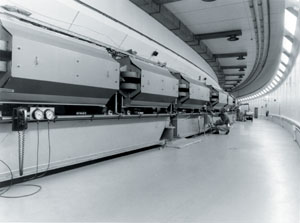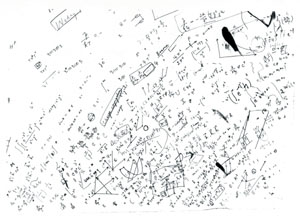When the Brookhaven National Laboratory was established in 1947 at Long Island’s Camp Upton, it inherited barracks, recreational facilities and a stockade for prisoners of war. Today the barracks remain, converted into offices, but the stockade has given way to world-class research facilities that cover topics from particle physics to the environment.
Brookhaven, funded today by the US Department of Energy, was born of the dreams of scientists returning from Los Alamos after the Second World War. They were looking for facilities to continue their research into the mysteries of the atom and they were unable to find them at their home universities. Soon, championed by Columbia physicists Isidor Rabi and Norman Ramsay, the idea of universities coming together to build a common research institute began to take shape. In 1947, nine north-eastern US universities clubbed together to form Associated Universities, Inc. with the goal of establishing a laboratory, and the model for many of today’s major laboratories, including CERN, was set.
Man-made cosmic rays
Not long after, plans for the Cosmotron – Brookhaven’s first particle accelerator – were laid. Taking its name from the cosmic rays that constantly shower down on Earth, the Cosmotron was the first accelerator to break the giga-electronvolt barrier, reaching energies as high as 3.3 GeV before it was switched off in 1966. The fact that it was also the first accelerator in the world to provide an extracted beam led to the Cosmotron being dubbed the world’s biggest slingshot by Popular Science magazine.

Scientifically, the Cosmotron lived up to its name, allowing all kinds of particle formerly seen only in cosmic rays to be studied in the laboratory. It was also the machine behind Brookhaven’s first Nobel prize. Two guest scientists working at the laboratory in 1956 – T D Lee and C N Yang – interpreted Cosmotron data as arising from parity violation in weak interactions, earning themselves a trip to Stockholm just one year later.
It is perhaps to accelerator physics that the Cosmotron left its greatest legacy, however. From the start, the Cosmotron’s builders recognized the limitations of synchrotrons as they were used at the time. In such machines, increasing particle energy was invariably accompanied by increasing orbit instability in the horizontal plane. To build a more powerful machine would require more powerful – and vastly heavier – magnets, imposing a practical upper limit on the energy achievable. The solution, developed by Ernest Courant, Stanley Livingston and Hartland Snyder in the 1950s, was to alternate the horizontal orientation of the bending magnets so that the field gradients in the horizontal plane also alternated. This principle became known as strong focusing and it opened the door to much higher energies.
By this time, Europe’s new laboratory, CERN, was getting off the ground. It was founded on the Brookhaven collegiate model with member states taking the place of Brookhaven’s universities. Links between the two laboratories were close and news of the strong focusing idea reached the European laboratory in time for it to recast its new proton synchrotron (PS) as a strong focusing machine. The CERN PS duly became the first operational, strong-focusing proton synchrotron in the world with a design energy of 25 GeV instead of the 10 GeV that would otherwise have been possible. Brookhaven’s Alternating Gradient Synchrotron (AGS) came on stream soon after and these two machines remain at the heart of the two laboratories’ accelerator complexes to this day.

The AGS has provided a rich harvest of physics for Brookhaven, earning the Nobel prize three times. Leon Lederman, Melvin Schwartz and Jack Steinberger had to wait until 1988 to receive the prize for their 1962 discovery of the muon neutrino. James Cronin and Val Fitch had a shorter wait, receiving the call to Stockholm in 1980 for their 1963 observation of CP-violation. Sam Ting picked up the prize for his 1974 discovery of the J/psi particle, along with Burton Richter of California’s SLAC laboratory, just two years later.
Physics in collision
Flush with the success of the AGS, Brookhaven set its sights high and in 1970 accelerator physicist John Blewett revived an earlier idea of building a machine to store and collide proton beams. Named project ISABELLE, Blewett’s plan was to build a pair of intersecting storage rings using the AGS as the injector. R&D for the new machine soon got under way and a ground-breaking ceremony was held in 1978. Soon after, however, a mixture of technical problems and changing political winds led to ISABELLE being dropped in favour of an even more ambitious project elsewhere – the Superconducting Super Collider – the downfall of which was later to send shockwaves around the world’s particle physics community.
Brookhaven persevered and was soon back with a new proposal to build a relativistic heavy-ion collider (RHIC) on the ISABELLE site. RHIC’s main aim would be to seek out and explore the exotic states of matter produced when heavy ions collide at huge energy densities. Using the AGS as the injector, RHIC would also serve as a proton-proton collider with the ability to collide polarized protons, helping to unravel the long-running mystery of nucleon spin. This part of the programme led to the establishment of a joint research initiative between Brookhaven and the Japanese Institute of Physical and Chemical Research (RIKEN) in 1995. The RIKEN-Brookhaven Research Center is now involved in the full RHIC programme and is also building a high-performance supercomputer for lattice QCD. Set to start up in March 2003, the new machine will reach 10 teraflops for the modest price tag of $5 million (about 50 cents per megaflop).

Accelerator-based programme
RHIC was switched on in 2000 following a decade of development and construction. The timing interlocked perfectly with a fixed-target, heavy-ion programme at CERN and provided a new focus for this line of research. RHIC’s first polarized protons were injected in December last year. With the AGS fixed-target research programme running concurrently with RHIC for the first time in 2001, Brookhaven’s accelerator-based programme is in rude health. The major thrust of the AGS programme is a long-running rare kaon decay experiment that published results recently on statistics of one event seen in 6 trillion kaon decays.
Particle physics at another AGS experiment was also recently in the spotlight with a new measurement of the muon’s magnetism, which appeared at first to be at odds with the Standard Model. A closer look at the theory, however, showed that it was the Standard Model that was at odds with the Brookhaven measurement. Science proceeds as an ongoing debate between experiment and theory. However, in modern-day particle physics it is rare that experiment leads the discussion.
National light source
Synchrotron radiation at Brookhaven could not come with a better pedigree. The phenomenon was predicted in the 1940s by, among others, the influential Brookhaven accelerator physicist John Blewett, who was then working for the General Electric Company. It was not until 1978, however, that synchrotron light research first made an appearance at the laboratory. Then, when the Department of Energy recognized the need for a national, second-generation light source, Brookhaven was chosen as the site. The National Synchrotron Light Source (NSLS) produced its first light in 1982 from a vacuum ultraviolet ring. An X-ray ring came on stream a few years later, and between them these two synchrotrons provide X-ray, ultraviolet, visible and infrared light to around 100 beamlines.
For the future, a proposed Center for Functional Nanomaterials will complement the NSLS. This will provide researchers with tools to make and study functional nanoscale materials. Functional materials are those that exhibit a predetermined chemical or physical response to external stimuli. The centre aims to achieve a basic understanding of how these materials respond when in nanoscale form. Nanomaterials offer different chemical and physical properties from bulk materials and have the potential to form the basis of new technologies.

Accelerating to the future
Today, Brookhaven is a laboratory relying heavily on its accelerator facilities for particle and nuclear physics as well as synchrotron radiation research. Keeping an eye on the future of these fields, the laboratory maintains an accelerator test facility (ATF) with a mission to explore new ideas on how to accelerate particles to higher energies and produce X-ray beams of greater brightness than ever. The ATF puts a range of accelerator and laser components at the disposal of a user community investigating the possibilities of novel acceleration techniques that will be necessary in the long term as experimental demands outstrip the possibilities of current-day technology.
The other main string to the fledgling Brookhaven laboratory’s bow was reactor-based physics. The laboratory’s first reactor – the Brookhaven Graphite Research Reactor (BGRR) – was developed at the same time as the Cosmotron. When it came on stream in 1950, it was the first peacetime reactor to be built in the US after the Second World War. Its dual mission was to produce neutrons for experiments and to refine reactor technology. The BGRR pursued a more applied line of research than its sister facility, the Cosmotron, leading, among other things, to the development of multigrade motor oils through the study of wear in engine components.
Reactor technology moved on and by the late 1950s, Brookhaven embarked on the construction of a new reactor capable of delivering much higher neutron fluxes than the BGRR. The High-Flux Beam Reactor (HFBR) produced its first self-sustaining reaction in 1965. Three years later the BGRR was shut down. HFBR research covered topics as diverse as basic nuclear physics and the development of radioactive isotopes for use in medicine.

The HFBR’s illustrious scientific career was marred by an unfortunate end in 1997 when a tritium leak was discovered at Brookhaven, leading to the most delicate period of the laboratory’s history. The tritium came from a leak in the HFBR’s spent-fuel pool and had remained undetected for many years. Careful sampling showed that the leak was confined and posed no danger to Brookhaven employees or the public. Brookhaven, however, found itself in the spotlight, both locally and globally, and implemented a strongly proactive community and media relations programme. Its image recovered, but too late for the HFBR, which has been permanently shuttered since 1999. The closure of a smaller reactor dedicated to medical research in 2000 marked the end of reactors at Brookhaven.
To physicists, Brookhaven is best known for its accelerator and reactor-based research, but as a multidisciplinary laboratory it also supports major programmes in life sciences and energy research. It was at Brookhaven that Lewis Dahl first identified the link between salt and high blood pressure in 1952. Also in the 1950s, Brookhaven scientists Walter Tucker and Powell Richards developed technetium-99m, the world’s most commonly used medical tracer. In the 1960s, George Cotzias began a programme of research at Brookhaven that led to the use of dopamine in the treatment of Parkinson’s disease.

In energy research, one of the laboratory’s highlights was triggered by the 1973 OPEC oil embargo when the US government turned to the laboratory for energy conservation solutions. This led to the Brookhaven energy house – a design concept aimed at reducing energy consumption in a family home simply by using conventional technology wisely. Built in 1980, the house uses solar energy and thermal storage to achieve dramatic energy savings. Its design has been widely imitated.

Today, Brookhaven is managed by Brookhaven Science Associates. It hosts a thriving research community at its flagship facility, RHIC. In particle physics, the laboratory is also the focal point for US participation in the ATLAS experiment at CERN. Brookhaven’s proud tradition in accelerator physics continues at the ATF, and the NSLS supports a thriving user community of some 2500 researchers. Brookhaven has also become a focus for the local community. Its mere presence on Long Island put more than $24 million into the local economy in 2001. More importantly for the laboratory and for the image of science locally, Brookhaven has become a centre of culture. A visit to its Web site at the time of writing revealed not only news about the molecular structure of cancer-related proteins unravelled at the NSLS, but also about an extravaganza of gospel music in an auditorium more used to the somewhat more sober proceedings of scientific colloquia.







